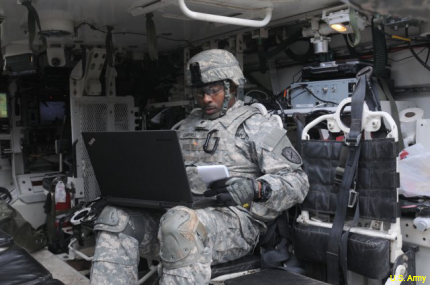Army looks outside the box in its Cyber Innovation Challenge
The service will use Other Transaction agreements, which operate outside normal procurement rules, to work on prototypes with non-traditional vendors.

The Army is looking for ways to improve cyber situational awareness in the field.
When it comes to situational awareness—knowing where you and your allies are, where the enemy is and what capabilities everybody has—the Army says its biggest shortcoming is in the cyber domain.
"It is the Army's number one gap to start to look to fill," Russ Fentonof the U.S. Army Training and Doctrine Command's Cyber Center of Excellence said during a recent industry day. "There is a list of cyber gaps, and at the top is situational awareness."
The industry day, held Nov. 18 in McLean, Va., was the kickoff for the Army’s Cyber Innovation Challenge, which looks to close that cyber awareness gap and do it through a fast-moving method of acquisition, testing and purchase that can help it keep pace with rapidly evolving threats.
A key element of the challenge is the use of Other Transaction Authority, a congressional authorization that allows Defense Department components (and some other federal agencies) to enter into transactions other than traditional contracts, grants or cooperative agreements for prototype products.
Through the innovation challenge, the Army plans to work with a consortium of government, academic and industry organizations—particularly small players that don’t typically work with DOD—to solicit, test and, if deemed worthy, buy small amounts of the prototypes to be tested and evaluated by soldiers in the field. Their feedback would help set specifications for future, larger procurements, the Army said.
"Our priority on cyber is to figure out how to make acquisition responsive to the requirements," said Kevin Fahey, executive director for System of Systems Engineering and Integration, Office of the Assistant Secretary of the Army for Acquisition, Logistics and Technology (ASA/ALT). "In this space, the best thing we can do is get it in the hands of users."
The current Cyber Innovation Challenge builds on an earlier challenge held from June to September this year, which focused on deployable kits for defensive cyber operations and resulted in Other Transaction agreements, known as OTs, being awarded to two vendors for prototype equipment.
The results of that first challenge gave Army officials reason to move forward. "Going through this process is fast," Fahey said. "It really did work - we got responsiveness to our requirements and we saw a lot of innovation."
DOD sees OTs as a flexible tool specifically for seeking new technologies outside of its typical contracting channels. They’re not a new idea, although they may come into wider use as DOD seeks to speed up its procurement cycles and work more with non-traditional contractors. Originally granted to NASA in 1958 with passage of the National Aeronautics and Space Act, OT authority has since been granted to seven other agencies, including DOD, and most recently was renewed, through 2018, as part of the 2013 National Defense Authorization Act.
OTs, which are not bound by the Federal Acquisition Regulations, require that at least one con-traditional contractor be involved, that at least a third of the funds spent on a prototype be paid for by parties outside the federal government and that the procuring agencies justifiy, in writing, the reasons for going outside the FAR process.
One thing the Army will be looking for in its challenge, specifically with regard to situational awareness, are tools that can analyze all the data coming in from sensors and other sources in order to quickly identify actionable intelligence. "We're trying to inform requirements and inform materiel solutions," Col. Bryan J. Stephens, director of the ASA(ALT) Cyber Focal, said. "We're looking for feedback on whether we're headed down the right path - help us shape it."
The Army said it is planning to hold three to four Cyber Innovation Challenges each year and use those technologies as part of its new Cyber Quest exercise, the first of which is planned for July 2016.
NEXT STORY: US approves sale of Global Hawks to Japan




